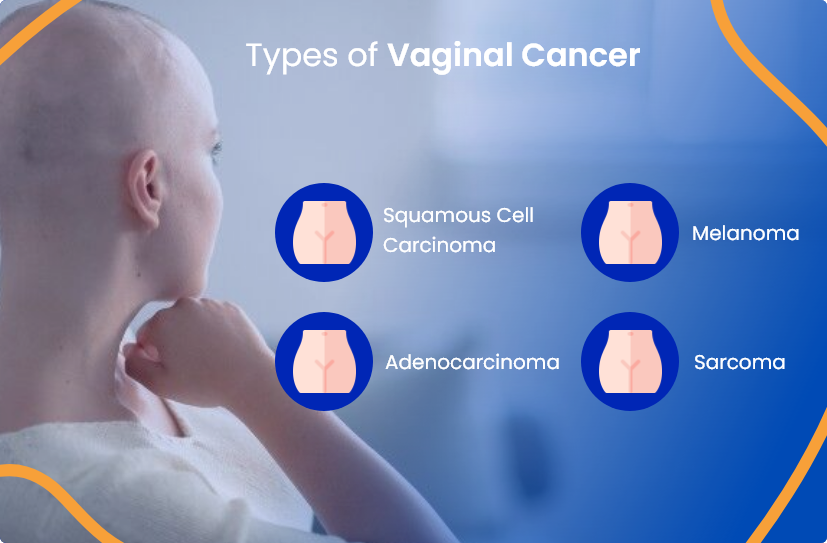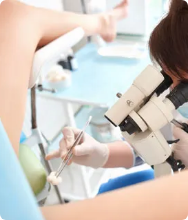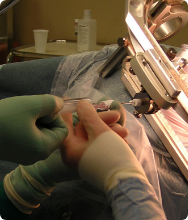
Book a Consultation
Thank you!
Your form has been sent successfully.

According to the American Cancer Society, vaginal cancer is a rare form of cancer. While it can affect women of any age, it is most common in those over 60. The vagina begins at the cervix (the lower part of the uterus) and opens at the vulva (the external female genitals). It develops when malignant (cancer) cells grow in the vaginal canal. The cancerous cells continue to grow and multiply, and the abnormal cells form a mass (vaginal tumor). If not treated on time, cancerous cells can enter nearby tissues and spread to other body parts or metastasize.
About 85% of malignancies that affect the vaginal area have mostly spread from other regions of the body, with the cervix or uterus accounting for half of them.
Following are the different types of vaginal cancer:

Squamous cell carcinomas account for about 9 out of 10 cases of vaginal cancer. These malignancies begin in the squamous cells that make up the epithelial lining of the vagina. They're most abundant near the cervix in the top section of the vagina.
Adenocarcinomas are cancers that arise in gland cells. They account for about one out of every ten instances of this rare form of cancer. Women above the age of 50 are more likely to develop adenocarcinoma. Young women who were exposed to the drug- diethylstilbestrol (DES) in utero (when in their mother's womb) are more likely to get diagnosed with clear cell adenocarcinoma.
Melanomas begin in pigment-producing cells. These tumors are most commonly discovered on sun-exposed skin but can also develop in the vaginal area or other internal organs. Melanoma accounts for less than 3 out of every 100 instances of vaginal cancer. It usually affects the lower or outer wall of vagina.
This is another rare type that originates deep within the wall of vagina rather than on the surface. Rhabdomyosarcoma and leiomyosarcoma are two kinds of sarcoma that can develop in the vaginal area.
Abnormal vaginal bleeding is the most prevalent symptom of this disease. Vaginal bleeding during or after menopause could indicate a problem, so in case this happens, consult your doctor immediately. Other vaginal cancer symptoms include:
 Abnormal vaginal discharge
Abnormal vaginal discharge
 Difficult or painful urination
Difficult or painful urination
 Pain during sexual activity
Pain during sexual activity
 Abnormal bowel function
Abnormal bowel function
 Pain in the pelvic area
Pain in the pelvic area
 Back or leg pain
Back or leg pain
The treatment option depends on the type of cell, the stage of cancer (how far it has progressed), and your age. Your doctor will decide on the best course of action for you. There are three types of treatments available for vaginal cancer :

The required type of surgery is determined by the stage and other factors. During an operation, the tumor and some surrounding healthy tissue are removed. Surgical options include vaginectomy (surgical removal of all or part of the vaginal wall) and hysterectomy (removal of the uterus, including the cervix).
Radiation therapy involves using high-energy x-rays or other forms of radiation to kill or stop cancerous cells from developing. It is divided into two types: External radiation therapy (Sending radiation from a machine outside the body to the cancerous spot) and Internal radiation therapy (Injecting a radioactive substance into or near cancer through needles or catheters). Vaginal cancer is treated with external and internal radiation therapy, which can also be used as palliative therapy.
Chemotherapy uses drugs to limit the growth of cancerous cells, either by killing them or preventing them from growing. Although chemotherapy can be given orally (by mouth), most medications for vaginal cancer are given intravenously (IV), injected directly into a vein or through a catheter. Early-stage vaginal cancer may be treated with intravaginal chemotherapy (drugs injected directly into the vagina).
Vaginal cancer can be diagnosed using various tests. When choosing a diagnostic test, your doctor may take into account the following factors:
In addition to a physical examination, the following tests may be used to diagnose vaginal cancer:

The doctor examines the vagina, the reproductive tract, the bladder, and the rectum, to check for any unusual changes.

Here, the doctor scrapes the outside of the cervix and vagina with a scraper and collects a sample of cells for testing.

An instrument called a colposcope is used to inspect the cervix and vagina.

Removal of a small amount of tissue for examination under a microscope.

This scan takes pictures of the inside of the body using x-rays taken from different angles.
ACTC's vaginal cancer specialists are committed to providing exceptional patient care by prescribing effective, individualized treatment strategies. We have some of Florida's most experienced providers on our team. Our professionals strive to provide a positive environment for patients and their families throughout their cancer journey.
The following are our providers who you can consult at ACTC:

MD, Hematology & Oncology

MD, Ph.D., Hematology/ Medical Oncology

MD, Radiation Oncologist

We are dedicated to providing personalized and comprehensive patient care. Our caregivers and staff are supported by a clinical team with over two decades of experience. Our facility includes an infusion room, medical and radiation oncology exam rooms, a treatment vault, and the latest diagnostic equipment for vaginal cancer treatment.
Schedule a consultation by calling
 352-345-4565
352-345-4565
Signs of vaginal cancer include bleeding from the vagina (often after intercourse, not related to menstruation), pain during intercourse, abnormal vaginal discharge, painful urination, and pelvic pain.
Cancer may appear in the form of small lumps (nodules) or sores (ulcers).
Human papillomavirus, or HPV, is one of the major causes of vaginal cancer.
Schedule a consultation by calling
 352-345-4565
352-345-4565